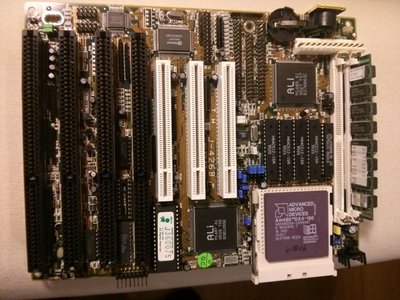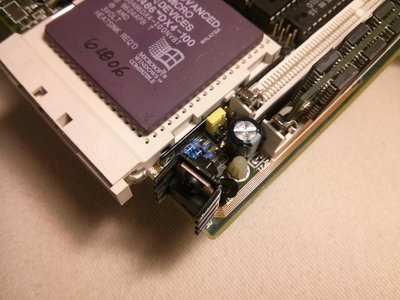First post, by devius
- Rank
- Oldbie
I've got a non-booting Socket 3 motherboard over here. It's one of those tiny late 486 boards with the Ali 1489/1487 chipset and an AMD Am486DX4-100:
The problem is that it doesn't boot. I've analyzed it the best that I can but I'm not sure what to do next. Here's what I found out:
- All other components work properly, only the motherboard itself doesn't
- With CPU, RAM, video card connected to monitor and a boot analyzer card attached to the parallel port the analyzer will briefly flash when turning on the system, but then turn off all LEDs
- If I disconnect the monitor cable but leave everything else in place the analyzer will then show some boot codes and all LEDs will remain lit when I turn the system on, but it will not actually boot
- The voltage regulator outputs only 1,8V instead of the expected ~3,45V as it's configured to do
- If I take out the CPU the voltage regulator outputs the expected ~3,45V
- Both the base and the collector of the TIP107 output transistor of the voltage regulation circuit show the same 1,8V voltage, but I'm almost certain there should be a difference
- There doesn't seem to be any blown components or cut tracks, although one of the tracks that connects power directly from the PSU connector to the ISA slots appeared to be a bit burnt in a spot, but it was only superficial, with the copper trace itself in good working order
This seems to point to some kind of problem with the CPU socket, or maybe the voltage regulation circuit, although I find it strange that it works properly without a CPU attached. Note that the CPU is verified to work correctly, and I also tried other similar CPUs and the result is the same. The voltage regulator is composed of a TL431 and two transistors, a 2N3904 and the aforementioned TIP107.
Here's a closeup of the regulator:
Any ideas? Should I just go ahead and replace the regulator components? They should be easy to source.

